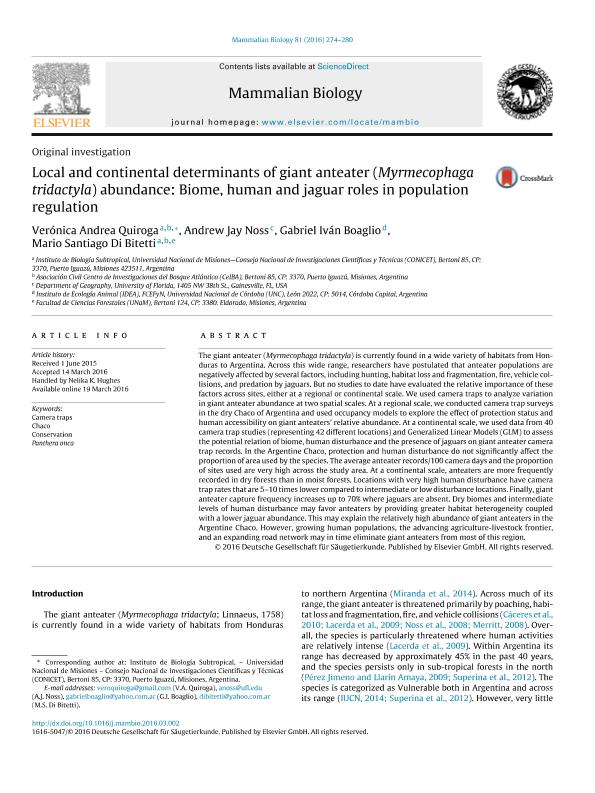Mostrar el registro sencillo del ítem
dc.contributor.author
Quiroga, Verónica Andrea

dc.contributor.author
Noss, Andrew Jay
dc.contributor.author
Boaglio, Gabriel Ivan

dc.contributor.author
Di Bitetti, Mario Santiago

dc.date.available
2018-06-29T16:50:05Z
dc.date.issued
2016-03-19
dc.identifier.citation
Quiroga, Verónica Andrea; Noss, Andrew Jay; Boaglio, Gabriel Ivan; Di Bitetti, Mario Santiago; Local and continental determinants of giant anteater (Myrmecophaga tridactyla) abundance: Biome, human and jaguar roles in population regulation; Elsevier Gmbh; Mammalian Biology; 81; 3; 19-3-2016; 274-280
dc.identifier.issn
1616-5047
dc.identifier.uri
http://hdl.handle.net/11336/50652
dc.description.abstract
The giant anteater (Myrmecophaga tridactyla) is currently found in a wide variety of habitats from Honduras to Argentina. Across this wide range, researchers have postulated that anteater populations arenegatively affected by several factors, including hunting, habitat loss and fragmentation, fire, vehicle collisions, and predation by jaguars. But no studies to date have evaluated the relative importance of thesefactors across sites, either at a regional or continental scale. We used camera traps to analyze variationin giant anteater abundance at two spatial scales. At a regional scale, we conducted camera trap surveysin the dry Chaco of Argentina and used occupancy models to explore the effect of protection status andhuman accessibility on giant anteaters? relative abundance. At a continental scale, we used data from 40camera trap studies (representing 42 different locations) and Generalized Linear Models (GLM) to assessthe potential relation of biome, human disturbance and the presence of jaguars on giant anteater cameratrap records. In the Argentine Chaco, protection and human disturbance do not significantly affect theproportion of area used by the species. The average anteater records/100 camera days and the proportionof sites used are very high across the study area. At a continental scale, anteaters are more frequentlyrecorded in dry forests than in moist forests. Locations with very high human disturbance have cameratrap rates that are 5?10 times lower compared to intermediate or low disturbance locations. Finally, giantanteater capture frequency increases up to 70% where jaguars are absent. Dry biomes and intermediatelevels of human disturbance may favor anteaters by providing greater habitat heterogeneity coupledwith a lower jaguar abundance. This may explain the relatively high abundance of giant anteaters in theArgentine Chaco. However, growing human populations, the advancing agriculture-livestock frontier,and an expanding road network may in time eliminate giant anteaters from most of this region.
dc.format
application/pdf
dc.language.iso
eng
dc.publisher
Elsevier Gmbh

dc.rights
info:eu-repo/semantics/openAccess
dc.rights.uri
https://creativecommons.org/licenses/by-nc-sa/2.5/ar/
dc.subject
Camera Traps
dc.subject
Chaco
dc.subject
Conservation
dc.subject
Panthera Onca
dc.subject.classification
Zoología, Ornitología, Entomología, Etología

dc.subject.classification
Ciencias Biológicas

dc.subject.classification
CIENCIAS NATURALES Y EXACTAS

dc.title
Local and continental determinants of giant anteater (Myrmecophaga tridactyla) abundance: Biome, human and jaguar roles in population regulation
dc.type
info:eu-repo/semantics/article
dc.type
info:ar-repo/semantics/artículo
dc.type
info:eu-repo/semantics/publishedVersion
dc.date.updated
2018-05-04T20:17:21Z
dc.journal.volume
81
dc.journal.number
3
dc.journal.pagination
274-280
dc.journal.pais
Alemania

dc.journal.ciudad
Jena
dc.description.fil
Fil: Quiroga, Verónica Andrea. Consejo Nacional de Investigaciones Científicas y Técnicas. Centro Científico Tecnológico Conicet - Nordeste. Instituto de Biología Subtropical. Instituto de Biología Subtropical - Nodo Puerto Iguazú | Universidad Nacional de Misiones. Instituto de Biología Subtropical. Instituto de Biología Subtropical - Nodo Puerto Iguazú; Argentina
dc.description.fil
Fil: Noss, Andrew Jay. University of Florida; Estados Unidos
dc.description.fil
Fil: Boaglio, Gabriel Ivan. Consejo Nacional de Investigaciones Científicas y Técnicas. Centro Científico Tecnológico Conicet - Córdoba. Instituto de Diversidad y Ecología Animal. Universidad Nacional de Córdoba. Facultad de Ciencias Exactas Físicas y Naturales. Instituto de Diversidad y Ecología Animal; Argentina
dc.description.fil
Fil: Di Bitetti, Mario Santiago. Consejo Nacional de Investigaciones Científicas y Técnicas. Centro Científico Tecnológico Conicet - Nordeste. Instituto de Biología Subtropical. Instituto de Biología Subtropical - Nodo Puerto Iguazú | Universidad Nacional de Misiones. Instituto de Biología Subtropical. Instituto de Biología Subtropical - Nodo Puerto Iguazú; Argentina
dc.journal.title
Mammalian Biology

dc.relation.alternativeid
info:eu-repo/semantics/altIdentifier/doi/http://dx.doi.org/10.1016/j.mambio.2016.03.002
dc.relation.alternativeid
info:eu-repo/semantics/altIdentifier/url/https://www.sciencedirect.com/science/article/pii/S1616504716300179?via%3Dihub
Archivos asociados
